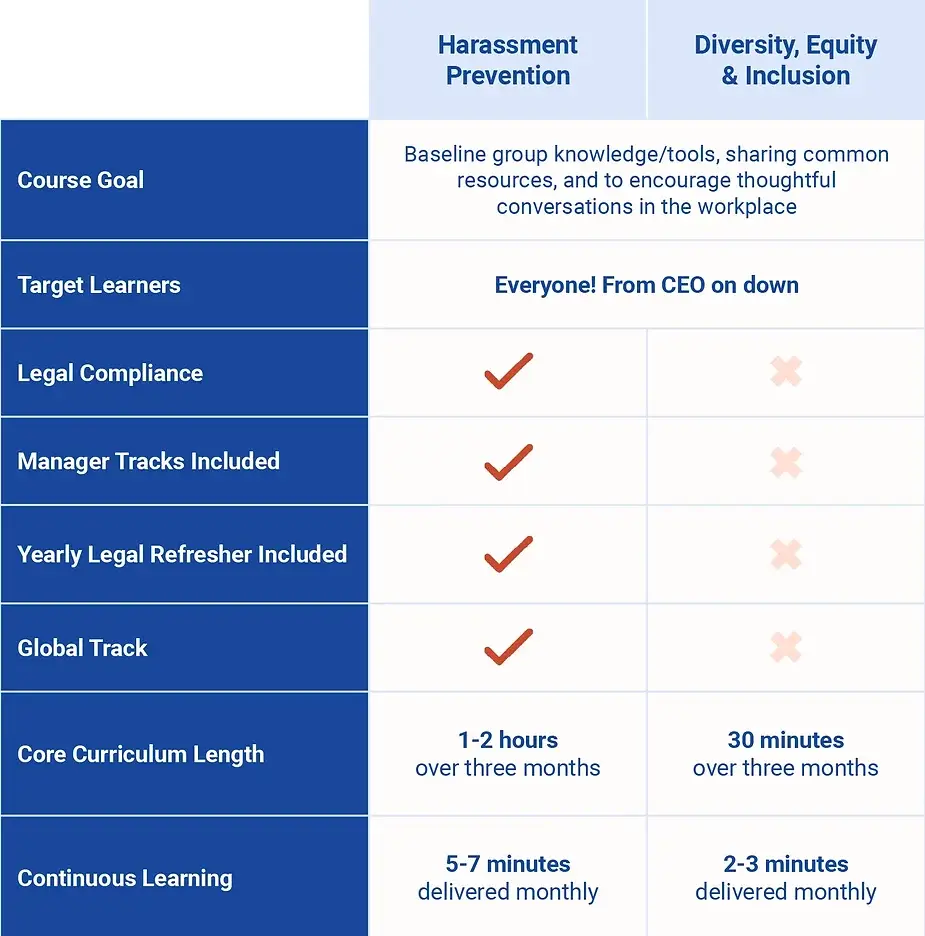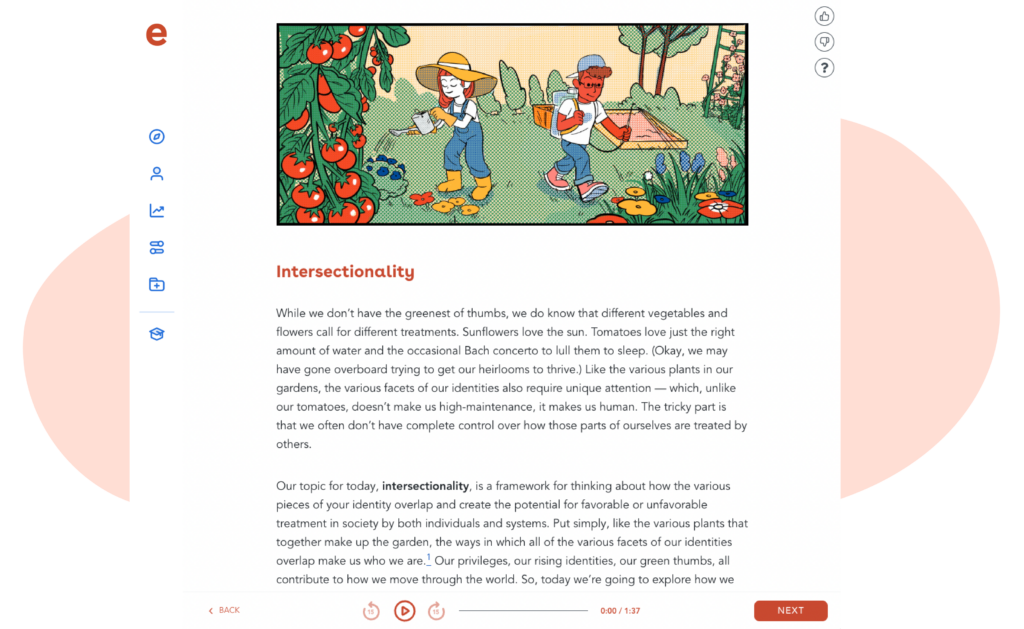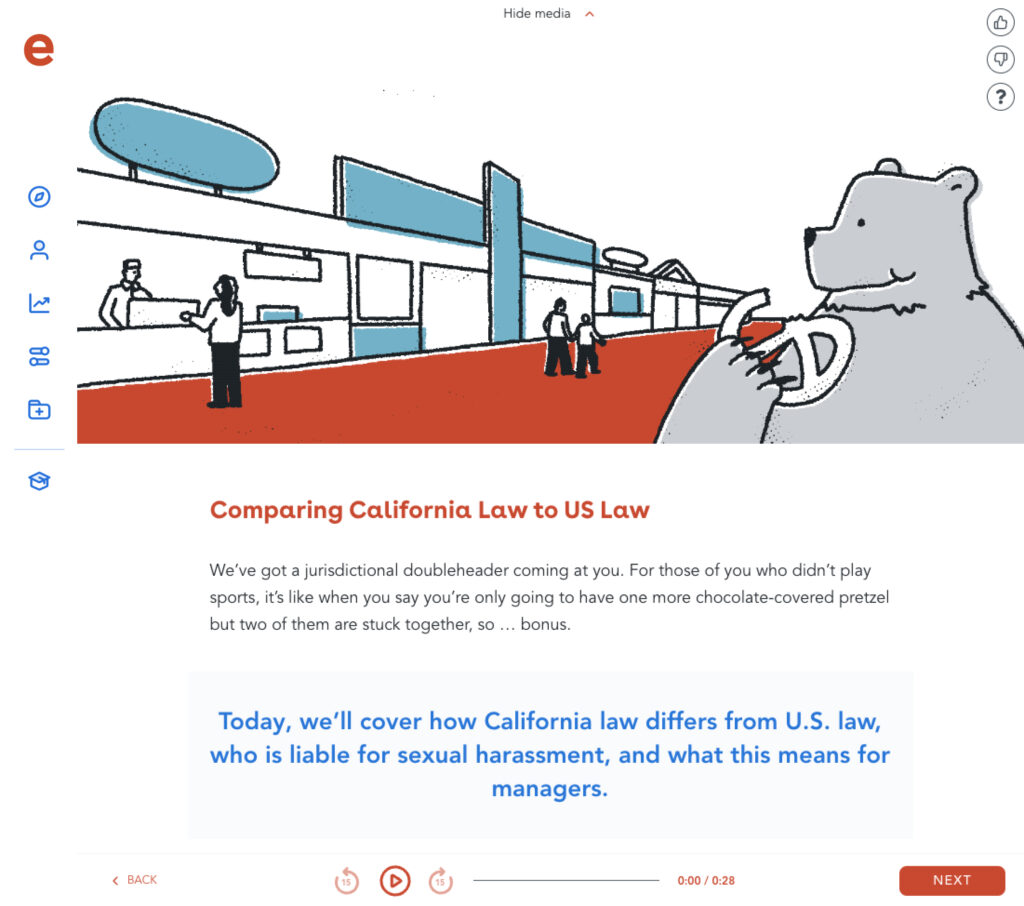“Should I be adding DEI to my annual compliance training?”
“Do teams need both sexual harassment training and DEI training?”
“What is the difference between Ethena’s Harassment Prevention and Diversity, Equity, & Inclusion trainings?”
Since we announced the launch of our Diversity, Equity, & Inclusion course, we’ve gotten questions like these a lot. And in all fairness, they’re great questions to ask! Leaders looking for effective training options for their teams are often working within budgets. And training fatigue is a thing, and can cause diminishing returns (and negative feedback from your team).
So, if you’re reading this and saying “DEI and Harassment Prevention matter a lot to my team, but I’m not sure if both trainings will work together cohesively,” this article is for you. Below, we’ll break down the benefits of both courses and how they stack up when paired together.
Where we started: sexual harassment training with DEI values
For years now, Ethena’s first-ever course, Harassment Prevention, has often been described in such terms as “harassment training with a DEI lens” or “training that addresses harassment prevention and diversity and inclusion topics.” In some of our early conversations with new Ethena customers, we distinctly recall describing our Harassment Prevention course as “a compliance course that also includes a lot of the necessary tools and definitions to have thoughtful DEI-related conversations year-round.”
Teams that train with Ethena’s Harassment Prevention can expect not only inclusive topics, lessons, and resources, but also DEI-related language and definitions to help round out annual sexual harassment training to something that feels much more modern.

It’s our own fault, really: to build a harassment prevention course for today’s teams, we feel that diversity and inclusion are necessary topics to cover. So it stands to reason that our customers who love Ethena’s Harassment Prevention are almost always interested in our Diversity, Equity, & Inclusion.
Pairing DEI and compliance together
Way back (2021), when Ethena was only providing Harassment Prevention, DEI training was one of our most-requested courses! And in the years since we officially launched our DEI course, we’ve had a handful of curious Ethena learners and admins who’ve been looking to add Diversity, Equity, & Inclusion to their workplace harassment training course load, and vice-versa.
Sexual harassment and diversity training course overviews, side-by-side
Let’s start with the basics. Who is each course for, and how long does the training take?
Course length comparison: Harassment Prevention and DEI

Harassment Prevention, as a compliance course, has a handful of required topics that must be covered – with required topics that change depending on where you’re training from (in example, see Chicago’s.)
Because of this, Ethena’s platform delivers a total of 1-2 hours of training to get everyone onboarded and compliant. Diversity, Equity, & Inclusion, on the other hand, does not have any specific laws dictating course structure or length, which is why it’s shorter. Both courses train year-round, every month, so learners enrolled in either of these courses can expect some new, hot-off-the-presses Ethena training in their inboxes every month.
To keep core concepts fresh, HP’s Continuous Learning nudges (“nudge” being one individual training lesson) are 5-7 minutes each, while the shorter-in-length DEI Continuous Learning is proportionally shorter at 2-3 minutes each month.

Who needs sexual harassment and diversity training?
Who should be taking these courses? Short answer: everyone! Both courses are chock-full of topics for entry-level team members and managers alike, but Harassment Prevention has a host of manager-specific courses (e.g. Mentorship, Gendered Feedback, etc.) that highlight best practices for leaders building safe and supportive communities in their workplaces.
Focusing on training goals: compliance vs. best practices
One of the easiest ways to distinguish these two courses is to focus on their objectives: what is the goal of each? You might take a look at their titles and say “Okay, one of these prevents harassment and the other promotes diversity, equity, and inclusion,” but the real answer is a bit deeper.

Ethena’s Harassment Prevention is designed to get learners compliant with annual sexual harassment training requirements, to encourage positive behavior change, and to build healthier work environments. Beyond the “check the box” baseline definitions and examples, Ethena’s Harassment Prevention takes extra steps to give everyone in the workplace the tools they need to have better, thoughtful conversations about harassment and all the ways it can manifest in daily life.
Once a team has trained with our Harassment Prevention course for over a year, Ethena’s platform automatically delivers a yearly legal refresher course to make sure compliance standards are met, with no additional work on the administrator’s side (that’s you, by the way!)

Diversity, Equity, & Inclusion is designed to help learners understand, support, and celebrate coworkers with rising identities (a term we picked up from one of our favorite recent reads, Did That Just Happen?!) through compassion and intersectional awareness. Just like I mentioned earlier, our DEI course is not obliged to any compliance standards, but that doesn’t mean that we haven’t taken the same best-in-class approach to making DEI just as thoughtful, well-researched, and relevant to the needs of today’s teams. After all, DEI and compliance are important values to us.
While each course has its own objectives, both courses aim to get everyone on the same page in terms of available resources, best practices, and common language, so teams can begin having better conversations and building a positive and healthy culture. Both courses provide certificates upon completion (for teams training with Harassment Prevention, these can be useful for compliance data reporting).
International lens to trainings
But one major differentiator is Harassment Prevention’s Global track for learners outside of the US. HP’s non-US learners are provided with the same resources as the US learners without US compliance laws attached, meaning they’ll be on the same page as their US coworkers without worrying about laws that may not apply to them.
Diversity, Equity, and Inclusion, however, is far too US-centric to be useful for learners outside of the US–topics like race, gender, sexual orientation, etc. have different cultural contexts in other countries. Because of this, Ethena’s Diversity, Equity, & Inclusion course has only one, US track.
What do both courses have in common? Ethena’s next-level research, delivery, and admin experience
This one’s an easy one, because Ethena approaches making all of our courses with the same rigorous, thoughtful, and user-focused approach.

Both Harassment Prevention and Diversity, Equity, & Inclusion are thoroughly informed and reviewed by best-in-class legal and subject-matter experts. And each course includes a variety of multimedia – custom illustrations, audio nudges, gifs and videos. Ethena’s platform allows admins to upload their own company policies to the platform, allowing for learners to reference company-specific guidelines, reporting instructions, and more.
What topics are covered in both courses, and how are they covered differently?
Browsing through the overview of both courses, you may notice there are a few subjects included in both Harassment Prevention and Diversity, Equity, & Inclusion. Which bears the question for those of us (including me) who are enrolled in both courses: are we doomed to repeat these subjects in our training twice?

Trust us, we anticipated this question. And the answer is no, despite having some overlapping topics, Harassment Prevention and Diversity, Equity, & Inclusion cover each of these topics differently. What’s important to note here is that context matters significantly.
For example, Bystander Intervention appears in Harassment Prevention as its own nudge and provides examples and tips about when and how to intervene when you witness harassment in the workplace.
In Diversity, Equity, & Inclusion, Bystander Intervention is introduced almost immediately alongside some of the first tools and definitions in the DEI course (it’s also framed by a custom, two-part video to illustrate its usefulness from an inclusion standpoint). While both courses define Bystander Intervention (one of our most powerful tools for individual impact on workplace culture), each course provides course-specific examples and context about how and when it should be used in everyday life.
Although some topics overlap, the material does not repeat beyond sharing definitions and best practices. Learners taking both HP and DEI can expect to deepen their understanding of topics like Bystander Intervention, Gender Identity, Sexual Orientation Inclusivity, Intersectionality, Bias, and Ableism as they learn about them in the contexts of each course.
To learn more about our full list of courses, check out our Courses page. Curious for a deeper look into Harassment Prevention and Diversity, Equity, & Inclusion? Talk to a member of our team!










